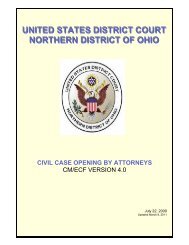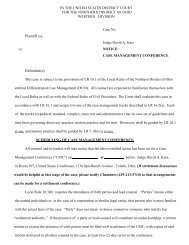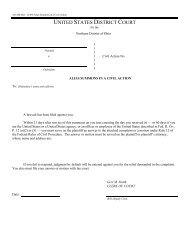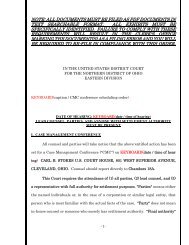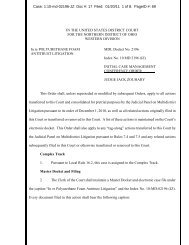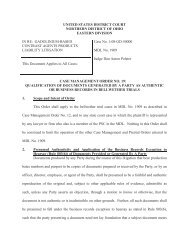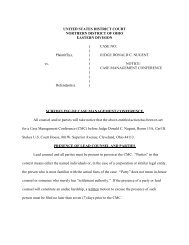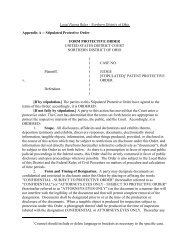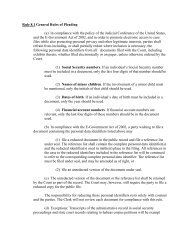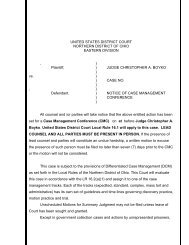1001 - Northern District of Ohio
1001 - Northern District of Ohio
1001 - Northern District of Ohio
You also want an ePaper? Increase the reach of your titles
YUMPU automatically turns print PDFs into web optimized ePapers that Google loves.
Case 1:03-cv-17000-KMO Document <strong>1001</strong> Filed 04/05/05 Page 6 <strong>of</strong> 10<br />
Lincoln Elec.’s Answer, Thirty-Sixth Defense.<br />
In response to the plaintiffs’ remand motion, the Ruth defendants argued this defense was simply<br />
a “placeholder” mechanism, allowing them to rely upon the defense if and when they discovered facts<br />
supporting it. The Court, however, rejected this “conditional” declaration <strong>of</strong> a defense as merely a<br />
mechanism to avoid the 30-day removal clock: “defendants’ general knowledge <strong>of</strong> the activities at Ingalls<br />
Shipyard and their assertion <strong>of</strong> affirmative defenses apparently borne out <strong>of</strong> that knowledge was sufficient<br />
to trigger their right to remove this action to federal court.” First Remand Order at 5 n.5. Put differently,<br />
“there was enough color to the defendants’ federal affirmative defenses at the time the defendants included<br />
them in their Answers, and enough facts known to the defendants, that removal was required under the<br />
bright-line rule recited in §1446. Reconsideration Order (docket no. 148) at 5-6.<br />
In contrast, in the Adames case, the complaint does not include any allegation even hinting that any<br />
<strong>of</strong> the plaintiffs ever welded on or near a Navy ship, or even in a shipyard, or even in a state where a<br />
shipyard sits. It is probably for this reason that, unlike in the Ruth case, none <strong>of</strong> the manufacturing<br />
defendants asserted the government contractor defense in their answers to the Adames complaint. The<br />
only defendant that asserted the government contractor defense was NEMA; as a trade association,<br />
NEMA is even more distant from the plaintiffs and would have no reason to know where the plaintiffs<br />
worked or what they welded. Thus, NEMA’s choice to assert the defense cannot fairly be characterized<br />
as borne out <strong>of</strong> any knowledge that a given plaintiff welded for the federal government or on government<br />
property. In sum, unlike in Ruth, there was no color to NEMA’s military contractor defense at the time<br />
NEMA included it in its answer.<br />
While the Court remains sure that its jurisdictional rulings in the Ruth case, as set out in the First<br />
6



